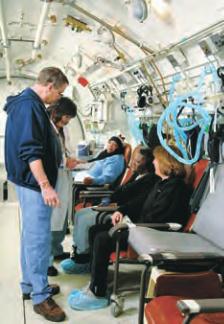Basic HTML Version



88
|
WINTER 2012
hyperbaric oxygen therapy would
appear more favorable, particularly
as a nearby major medical center
had been treating injured divers for
several decades. Due to budgetary
issues, however, this hospital had
reduced the number of days per week that the hyperbaric
medicine service would be on call. Tuesday was one of the
noncall days. This diver, therefore, had experienced a double
misfortune. Not only had he suffered DCS, he had done so
on a Tuesday. Unfortunately, the reduced availability of this
service had not been widely communicated, particularly
to those in a position to refer emergent cases or effect
their transfers. After some delay, the diver was eventually
transferred elsewhere in the state and was fortunate to
experience complete clinical resolution of his symptoms.
The lone survivor of a coal-mine disaster was rescued after
being trapped underground for several days. He was comatose
at the time of his rescue and urgently transferred to a nearby
medical center in West Virginia. His primary problem was
severe carbon-monoxide poisoning. Not having a hyperbaric
medicine program, this hospital requested urgent transfer to
a nearby hospital that did. Their request was denied on the
grounds that the hyperbaric medicine facility was unavailable
for emergent cases (it operated as an outpatient wound-care
hyperbaric facility). Transfer was arranged some days later
to a 24/7 hyperbaric medicine service in a neighboring state.
The patient had a protracted hospitalization and incomplete
neurological recovery at the time of his discharge.
A History of HyperbAric cAre in tHe U.s.
To put this serious issue in perspective, one needs to reflect
on the evolution of HBOT. Early hyperbaric chambers were
not hospital-based. Rather, they could be found at various
industrial and commercial worksites. These chambers served
in support of civil-engineering projects such as bridges and
tunnels constructed above and beneath various bodies of
water. Underground mass-transit systems were another
common worksite in which a chamber might be present.
Caisson workers employed in these projects would enter
chambers to decompress from their pressurized work
environments. They would return to the chambers to be
recompressed (treated) should their decompression schedules
prove incompletely protective. By the 1950s a growing number
of military diving operations were also supported by onsite
recompression chambers.
It was not until the early 1960s that hyperbaric chambers
found their way into the hospital setting. During this
period several newly identified therapeutic mechanisms
were associated with hyperbaric doses of oxygen. These
mechanisms served to extend hyperbaric medicine’s use
beyond the treatment of DCI. Patients hospitalized with
acute traumatic crush injuries, carbon-monoxide poisoning
or gas gangrene were now considered referable to hyperbaric
medicine. The ensuing years were characterized by a steady
growth in the geographic availability of hospital-based
hyperbaric chambers and the number of treatable conditions.
At this point, essentially every hyperbaric medicine program
was organized and staffed to provide 24/7 care, such was the
nature of the majority of its common uses.
A new bUsiness Model
By the late 1980s, utilization of the hyperbaric chamber for
wound-healing deficiencies was becoming commonplace. As
most of these wounds were chronic, patients were not usually
hospitalized. Rather, they traveled to and from the hospital
for daily treatments. During the mid-1990s a unique business
model was created, one that combined hyperbaric medicine
and wound-healing services. This model blossomed to the
extent that the great majority of subsequent hyperbaric
medicine programs have been organized and operated in this
manner.
The model’s concept was not to provide hyperbaric
medicine for the full range of accepted uses. Rather, access
was limited to outpatients, essentially those suffering
deficient wound healing. And it was only available during
in addition to decompression illness,
hyperbaric oxygen therapy is used to treat
diabetic foot ulcers, delayed effects of
radiation, threatened flaps/grafts, acute
carbon monoxide poisoning, crush injuries,
refractory osteomyelitis, gas gangrene and
necrotizing fasciitis.
S T E P H E N F R I N K
COUR T E S Y U P E NN
S T E P H E N F R I N K
86-89_Chambers_Winter2012.indd 88
1/13/12

